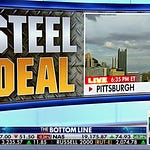China’s Electric Vehicles Are Going to Push Detroit To Another Bail Out
By Lauren Fix
It happened very quickly, so fast that you might not have noticed it. Over the past few months, America’s Big Three automakers — Ford, General Motors, and Stellantis (the oddly named company that owns Dodge, Chrysler and Jeep) — landed in big trouble. Tesla is actually one of the Big 3 US car makers as Stellantis is now based in Belgium.
I realize this may sound silly. Ford, General Motors, and Stellantis made billions in profits last year, even after a lengthy strike by UAW autoworkers, and all three companies are forecasting a big 2024. But recently, the Big Three found themselves outmaneuvered and missing their goals for electric vehicle sales at the same time that a crop of new affordable, electrified foreign cars appeared, ready to flood the global market. Possibly from China, if they are allowed to import them into the US.
About a decade ago, America bailed out the Big Three. Politicians and taxpayers swore they would not do it again. But the federal government is going to have to help the Big Three and the rest of the U.S. car market again, very soon, and this is a bad idea.
The biggest threat to the Big Three comes from a new crop of Chinese automakers, especially BYD, which specialize in producing plug-in hybrid and fully electric vehicles. BYD’s growth is astounding. It sold three million electrified vehicles last year, more than any other car company, and it now has enough production capacity in China to manufacture four million cars a year. BYD is building new factories in Mexico, Brazil, Thailand, Hungary and Uzbekistan, which will produce even more cars. A deluge of Chinese vehicles is coming.
BYD’s cars deliver great value at prices that beat anything coming out from other brands. Recently, BYD unveiled a plug-in hybrid that gets decent all-electric range and will retail for just over $11,000. How can they sell vehicles at that low price? Like other Chinese manufacturers, BYD benefits from its home country’s lower labor costs, but this explains only some of its success. The fact is that BYD and Chinese automakers like Geely, which owns Volvo Cars and Polestar brands, are very good at making cars and they are subsidized by the Chinese government. This lowers the price of vehicles to consumers. They have leveraged China’s dominance of the battery industry, they own most of the mines and have automated production lines to build cars faster. This means using less people are reducing costs.
Ford and GM plotted an ambitious EV transition three years ago. But it didn’t take long for them to stumble. Last year, Ford lost more than $64,000 on every EV that it sold. Since October, it has delayed the opening of one of its new EV battery plants, and GM has fumbled the start of its new Ultium battery platform, which is meant to be the foundation for all of its future electric vehicles. Ford and GM have had some wins, with the Mustang Mach-E and Chevrolet Bolt being modest hits. But they aren’t competing at the level of Tesla and Hyundai — companies that operate factories in less union-friendly states.
The other looming problem for Ford and General Motors is that their balance sheets, while they look robust, conceal a huge vulnerability. While the two companies have done generally well in recent years, their billions in profits have overwhelmingly come from selling a small number of vehicles to a small group of people. Specifically, Ford and GM’s earnings rest primarily on selling pickup trucks, SUVs and crossovers to affluent North Americans.
This creates a strategic issue for them, they must use their strong truck and SUV earnings to subsidize less profitable vehicle business and learn how to make EVs profitable without the tax incentive. If they can figure it out, they will survive.
That’s why the flood of cheap Chinese electric vehicles poses such a big problem: It could ruin Ford and GM’s marketshare. Even a wave of competitive electric cars from automakers like Kia, could eat away at their SUV profits before they’re ready.
The Chinese carmakers are the first real competition that the global car industry has faced in decades when the Japanese and then the Koreans entered the car market.
The outgoing administration is finalizing rules that will effectively bar nearly all Chinese cars and trucks from the U.S. market, as part of a crackdown on vehicle software and hardware from China. This will leave the ball in President-elect Donald Trump’s court when he takes office. Trump wants to prevent Chinese auto imports but is open to Chinese automakers building vehicles in the U.S.
President Trump plans to gut the Inflation Reduction Act, and place tariffs on China and other countries.
This could one way to protect the US auto industry. Import restrictions imposed on Chinese cars in the next few years won’t necessarily be permanent. That might encourage American companies to learn everything they can from their new Chinese competition.
Another important factor to know is that Chinese Industry analysts have been predicting a shakeout in the Chinese auto industry and it looks like it already started. Out of the 112 brands that sell EVs, 23 of them either folded or were consolidated with another automaker in 2024. Taken as a whole, the Chinese industry is operating below 50% capacity utilization. The CEO of Xpeng predicts that the Chinese industry has entered the “elimination round” where a lot more automakers will disappear over the next two years.
The largest state owned automakers like SAIC and FAW are expected to survive, and so are the large independent companies like BYD, Li Auto, Great Wall and NIO. But the smaller companies won’t be able to compete with them and will start to go out of business.
For many Chinese automakers 2025 is going to be a really tough year. Even so, the ones that survive are going to be extremely competitive and that will make the Chinese auto industry even stronger than it is today.
Excess capacity among carmakers in China is driving the world's largest auto market into a shakeout phase. Chinese carmakers are looking overseas to absorb their production. That is getting harder because of rising trade barriers and tariffs. The US is not alone, the European Union in October imposed tariffs of up to 45% on made-in-China EVs, as China has negatively impacted the German economy.
We will keep you posted on the industry, but we do not want to bail out any car companies. The car companies need to build vehicles people want, without subsidies, with out politics, just build what we want to drive and they will survive.
You can support me by buying me a cup of coffee. Thanks for subscribing and your support! https://www.buymeacoffee.com/laurenfix
Looking for more automotive news?
https://www.CarCoachReports.com
Total Car Score Podcast ► https://www.revolverpodcasts.com/shows/total-car-score/














Share this post